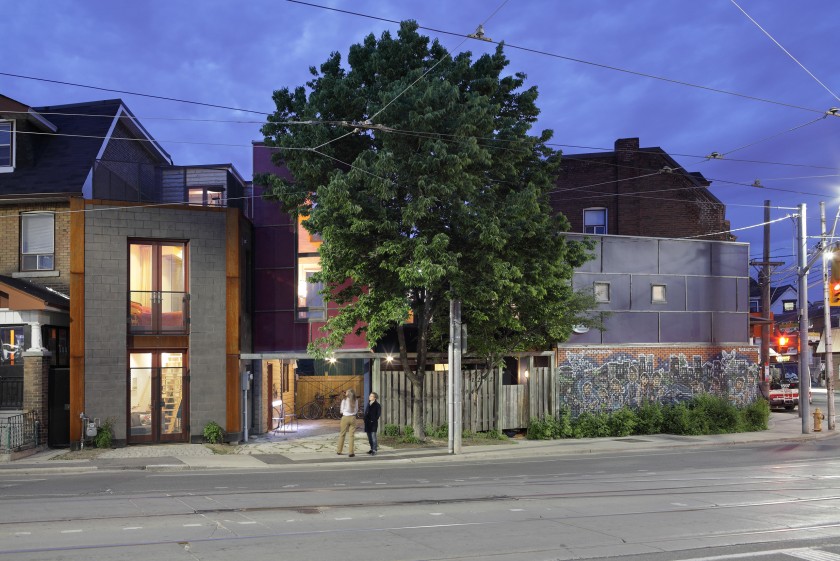
Special to The Globe and Mail
Last updated Thursday, Jun. 20 2013, 11:18 AM EDT
‘I love a challenge,” Rohan Walters says with a laugh as he settles into a couch beside a pair of French doors. On the other side of those doors, a pedestrian double-takes as she passes, not expecting a living room a metre from the sidewalk.
The challenge, however, was not to befuddle pedestrians at College and Lansdowne. Rather, the soft-spoken 52-year-old challenged himself with placing a home on what was, until recently, a “remnant” of the urban fabric so small it had been completely overlooked. Except by him: The Waterloo architecture graduate first spied this 10-by-37-foot driveway two decades ago, but attempts to contact the B.C.-based landowner had failed, so he purchased the lot beside it, another forgotten scrap of land, at 1292 College St. W., instead.
The ‘Driveway House’ fits an odd Toronto lot
By 1996, he’d built “Triangle House” for his family on that scrap (which has also swivelled many a neighbourhood neck) while the driveway next door continued to sit empty (there were illegally parked cars and trucks as well as the odd condom wrapper, so it wasn’t empty, technically, but that’s another story).
Three years ago, Mr. Walters learned his coveted urban remnant was in tax arrears. Although he couldn’t secure funds, he persuaded a big corporation he’d been doing some work for to purchase it. And they, in turn, asked Mr. Walters to design something. But not just any old thing: Plans were hatched for a three-unit, three-level, experimental dwelling that would include a vertical axis wind turbine. In addition, the ground floor unit would be completely barrier-free for a wheelchair-using tenant.
It was to be about “future visioning,” explains Mr. Walters, but, after a shift in leadership, the corporation pulled the plug on that future.
Luckily, they were nice enough to hold the property until Mr. Walters could raise funds. Unfortunately, his smaller purse meant he had to scratch the wind turbine and the idea of separate apartments. But, thinking of “flexible housing, social relevance [and] changing demographics,” he decided to keep the barrier-free aspect on the ground floor: “That’s a principle that is timeless. I’m going to hold onto that. I’m going to demonstrate that.”
And, since the chief cook and bottle washer at Spaces by Rohan Inc. has never been one to shy away from a striking design – Mr. Walters is responsible for the “Lego” house at 157 Coxwell Ave. – he’d make this, the “Driveway House,” just as memorable. “If something is ugly,” he opines, “people are going to find a way to change it, or tear it down, or divest themselves of it.”
So, now, beside Mr. Walters’s own two-storey home – with its faded maroon and navy blue panels and graffiti-inspired artwork – stands an even bolder 1,084-square-feet statement on how to fill a gap in the urban smile.
Rusty Cor-Ten steel frames a svelte, dark-tinted cinderblock box punctuated by two sets of French doors, with the bottom set practically kissing the sidewalk. A small half-floor that looks like a forest lookout tower leads to a massive, third-floor roof deck, except the only tree to watch is the tall ash that Mr. Walters planted in 1996.
Inside, however, Mr. Walters has softened things considerably. Here, raw wood rules: Ceiling joists, window casings and staircases have all been left bare. Upstairs, it’s the same, with the addition of sliding plywood barn doors. Open wood, explains Mr. Walters, regulates humidity, and softens the somewhat harsh LED lighting used throughout.
Plywood hides behind every inch of drywall on the ground floor so, if needed, pull-bars and drop-tables can be attached in future (his current tenant does not use a wheelchair). Reinforcing the walls this way, says Mr. Walters, means the ground floor could easily adapt to a new use, such as an art gallery: “That’s what we don’t do enough of here,” he laments. Also, all electrical outlets and light switches are located at wheelchair height behind a long aluminum strip (a modern take on the chair-rail).
One can easily roll under the kitchen sink, or the sink mounted on a piece of laminated steel in the large main-floor bathroom. Threshold-free, the bathroom floor slopes at a 1.25 degree angle for drainage, with plenty of room for wheeling around. Behind sliding doors are the “guts” of the house: radiant floor system, boiler, HRV, electrical panel, and a washer/dryer combo unit that sips on 15-amps.
The second floor consists of a dressing area, another bathroom and the master bedroom. Instead of enclosing it with walls, the stairwell has been glassed in “so that you don’t think you’re in a small space.” Helping enlarge this floor are nine-foot ceilings. The third floor, with its seven-foot ceiling height, would make for a lovely office or child’s bedroom. Throughout, industrial cable “raceways” hanging from the ceiling carry electrical lines and double as storage for shoes and other small items.
As with much of Rohan Walters’s work, the Driveway House is a challenge to understand visually, despite the “familiar materials” employed. It’s an unapologetic urban housing haiku written in big upper case letters: Blink and you’ll miss it, but stop to take it in and it’ll punch you in the nose.
But a punch in the nose might be just what most developers need when it comes to housing issues such as flexibility, limited mobility and aging-in-place. “If I can do it on a lot this size,” he says, “there is no excuse for not doing it anywhere else.”